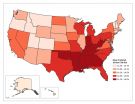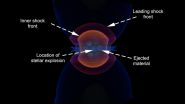Endothelin gene expression is greatly increased in the retinal tissue of a mouse model of retinopathy of prematurity, a condition that significantly affects about 1,500 infants annually, resulting in blindness in about half those babies, according to researchers at the Medical College of Georgia at Georgia Regents University.
The finding points toward a new therapy to help prevent the damage as well as a broader role for endothelin, known as a powerful blood pressure regulator, which also appears to have a role in blood vessel formation, said Dr. Chintan Patel, MCG postdoctoral fellow and first author of the study in The American Journal of Pathology.
Despite long-standing strategies to give premature newborns the lowest oxygen therapy possible to protect fragile, immature tissues such as the retina while providing adequate support to vital organs, vision damage remains an ongoing concern in neonatal intensive care units, said Dr. Jatinder Bhatia, Chief of the MCG Section of Neonatology.
In addition to immediate impacts on vision, the condition increases a child's risk of retinal detachment, nearsightedness, crossed eyes, lazy eye, and glaucoma, according to the National Eye Institute.
The retina is part of the brain and, like the rest of the brain, it continues to develop even after full-term birth, said Dr. Ruth Caldwell, cell biologist at MCG's Vascular Biology Center and the study's corresponding author. The soft, three-layered tissue, found at the back of the eye, contains light-sensitive cells, which transform light into a signal for the brain.
The cup-shaped tissue is normally super vascular, but in premature babies, retinas, which are not yet ready to function, likely have not formed blood vessels throughout. Oxygen therapy, necessary to support other organs, further slows blood vessel development so the retina become ischemic. Neurons and supporting cells start secreting proteins and growth factors to try to recuperate from the lack of oxygen and nutrients to these areas, which instead, leads to formation of leaky, malpositioned blood vessels. "There is a dysregulation of growth factors that occurs at a microscopic level," Patel said.
There are a number of other things happening at the same time, which also are not good. High-oxygen levels also increase levels of oxidative stress, which increases inflammation in the face of decreased production of growth factors needed to produce healthy blood vessels, Patel said. Blood vessels start growing in every direction, including on top of each other. "We call it pathological neovascularization," he said.
Protruding blood vessels can create enough stress to actually detach the retina, the main cause of visual impairment and blindness from retinopathy of prematurity, according to the National Eye Institute. Vascular endothelial growth factor, which is essential to neuron growth, is considered a primary culprit in retinopathy of prematurity as well as diabetic retinopathy, in which it contributes to a similar problem with erratic, leaky blood vessel growth that obstructs vision.
In their animal model of retinopathy of prematurity, mice born at term were given high-oxygen levels seven days later, which destroys some of the vessels that have developed and essentially halts the development of new ones as the immature retina continues to develop. They note that even at term, mice eyes remain shut for a few weeks because, as with premature babies, they are not yet ready to function.
Cell sensors that keep up with oxygen exposure, sense too much oxygen and stop growing, so blood vessels don't form, Caldwell said. The return to normal airs seems like oxygen deprivation by comparison, so, similar to what happens in diabetic retinopathy where retinal blood flow is compromised, mice start growing many, obstructive blood vessels. "In a premature baby, some of the parts of the retina are not fully developed because of high oxygen, so it's a similar scenario," Patel said.
When the scientists looked at gene expression in retinal tissue five days after the return to normal air - considered the peak period of dysregulated blood-vessel growth - they found about a 50-fold increase in the expression of endothelin 2, a potent blood pressure regulator and blood vessel constrictor in normal conditions, and about a three-fold increase in endothelin 1, also a constrictor. There was also a significant increase in endothelin receptors.
Way more vasoconstriction likely translates to far less blood vessel dilation. Endothelin and the equally powerful dilator nitric oxide tend to have a reciprocal relationship, Patel explained. "If you have more endothelin, you have less nitric oxide and vice versa," he said.
While other genes, including VEGF, had increased expression, endothelin's was the most dramatic and indicates its role in blood vessel formation. The scientists don't yet know if it's a direct effect or secondary to its role in blood pressure regulation. Although the emerging role of endothelin in cancer, where it appears to help tumors survive, indicates a direct one. "We are seeing a lot of the same things here," Patel said.
Anti-VEGF therapy is often given for diabetic retinopathy and more selectively for retinopathy of prematurity. However, the scientists note that there is increasing evidence that other potential factors may also need regulating.
Endothelin may need to be as well. Because, when they gave endothelin receptor blockers, already used to treat other conditions, to the mice prior to the peak period of dysregulated growth, they helped normalize blood vessel growth.
"What we need is a therapy that does multiple things," Patel said. Caldwell noted that in diabetic retinopathy, while anti-VEGF therapy is good at stopping dysregulated growth, it doesn't help spur normal blood vessel growth, which the endothelin receptor blocker did in their studies.
INFORMATION:
Next steps could include seeing if an endothelin antagonist will also work to correct dysregulated growth after it has occurred and packaging it with anti-VEGF therapy. The research was supported by the National Eye Institute, the Department of Veterans Affairs, the American Heart Association, and the GRU Culver Vision Discovery Institute.
Toni Baker
Communications Director
Medical College of Georgia
Georgia Regents University
706-721-4421 Office
706-825-6473 Cell
tbaker@gru.edu



